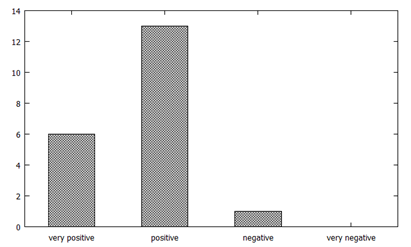How do students respond to using the Sevima Edlink Application in learning at the university?
DOI:
https://doi.org/10.12928/jrkpf.v9i2.141Keywords:
sevima edlink, student responses, thermodynamics courseAbstract
This study aims to analyze student responses to online learning using the Sevima edlink application. The research includes a type of descriptive research with a quantitative approach. The research will be carried out in the 2021/2022 academic year. The study population was IKIP Muhammadiyah Maumere students, and the sample was 3rd and 5th-semester Physics Education Students, totaling 20 people. Sampling using a simple random sampling technique. Data was collected using a questionnaire specified in the Google Form form. Questionnaires were distributed to physics education students who took thermodynamics online courses in semesters 3 and 5. Data analysis using percentage technique. The results showed that 80.81% of students responded positively to using the Sevima Edlink application in thermodynamics lectures. From the analysis results, it can be concluded that the average student responds positively to taking online lectures on thermodynamics courses using the Sevima edlink application.
References
P. Sahu, “Closure of Universities Due to Coronavirus Disease 2019 (COVID-19): Impact on Education and Mental Health of Students and Academic Staff,” Cureus, Apr. 2020, https://doi.org/10.7759/cureus.7541.
F. Fredy, L. A. Prihandoko, and A. M. Anggawirya, “The Effect of Learning Experience on the Information Literacy of Students in the Ri-Png Border During Covid-19 Period,” Int. J. Multicult. Multireligious Underst., vol. 7, no. 10, p. 171, Nov. 2020, https://doi.org/10.18415/ijmmu.v7i10.2067.
E. J. Sintema, “Effect of COVID-19 on the Performance of Grade 12 Students: Implications for STEM Education,” Eurasia J. Math. Sci. Technol. Educ., vol. 16, no. 7, pp. 1–6, Apr. 2020, https://doi.org/10.29333/ejmste/7893.
L. S. Schlesselman, “Perspective from a Teaching and Learning Center During Emergency Remote Teaching,” Am. J. Pharm. Educ., vol. 84, no. 8, p. ajpe8142, Aug. 2020, https://doi.org/10.5688/ajpe8142.
O. Zawacki‐Richter, “The current state and impact of Covid‐19 on digital higher education in Germany,” Hum. Behav. Emerg. Technol., vol. 3, no. 1, pp. 218–226, Jan. 2021, https://doi.org/10.1002/hbe2.238.
J. C. J. Parker, “The Cambodian experience: Exploring university students’ perspectives for online learning,” Issues Educ. Res., vol. 27, no. 4, pp. 697–719, 2017.
M. Mather and A. Sarkans, “Student Perceptions of Online and Face-to-Face Learning,” Int. J. Curric. Instr., vol. 10, no. 2, pp. 61–76, 2018.
O. A. Pilkington, “Active Learning for an Online Composition Classroom: Blogging As an Enhancement of Online Curriculum,” J. Educ. Technol. Syst., vol. 47, no. 2, pp. 213–226, Dec. 2018, https://doi.org/10.1177/0047239518788278.
K. Arizona, Z. Abidin, and R. Rumansyah, “Pembelajaran Online Berbasis Proyek Salah Satu Solusi Kegiatan Belajar Mengajar di Tengah Pandemi Covid-19,” J. Ilm. Profesi Pendidik., vol. 5, no. 1, pp. 64–70, May 2020, https://doi.org/10.29303/jipp.v5i1.111.
A. J. B. Hutauruk, “Kendala Pembelajaran Daring Selama Masa Pandemi di Kalangan Mahasiswa Pendidikan Matematika: Kajian Kualiatatif Deskriptif,” Sepren, vol. 2, no. 1, p. 45, Sep. 2020, https://doi.org/10.36655/sepren.v2i1.364.
A. Abidah, H. N. Hidaayatullaah, R. M. Simamora, D. Fehabutar, and L. Mutakinati, “The Impact of Covid-19 to Indonesian Education and Its Relation to the Philosophy of ‘Merdeka Belajar,’” Stud. Philos. Sci. Educ., vol. 1, no. 1, pp. 38–49, Apr. 2020, https://doi.org/10.46627/sipose.v1i1.9.
T. Meriana, A. Angelius Domes, Y. -, and H. Sihotang, “The Impact of The Covid-19 Pandemic on Students Behaviour During Online Learning at Pelangi Kasih Elementary School in Jakarta,” Adv. Soc. Sci. Res. J., vol. 8, no. 4, pp. 594–604, May 2021, https://doi.org/10.14738/assrj.84.10112.
A. P. Putri, R. S. Rahhayu, M. Suswandari, and P. A. R. Ningsih, “Strategi Pembelajaran Melalui Daring dan Luring Selama Pandemi Covid-19 di SD Negeri Sugihan 03 Bendosari,” Prima Magistra J. Ilm. Kependidikan, vol. 2, no. 1, pp. 1–8, Mar. 2021, https://doi.org/10.37478/jpm.v2i1.728.
A. Widodo and N. Nursaptini, “Problematika Pembelajaran Daring dalam Perspektif Mahasiswa,” ELSE (Elementary Sch. Educ. Journal) J. Pendidik. dan Pembelajaran Sekol. Dasar, vol. 4, no. 2, p. 100, Aug. 2020, https://doi.org/10.30651/else.v4i2.5340.
A. Wibowo and I. Rahmayanti, “Penggunan Sevima Edlink Sebagai Media Pembelajaran Online untuk Mengajar dan Belajar Bahasa Indonesia,” Imajeri J. Pendidik. Bhs. dan Sastra Indones., vol. 2, no. 2, pp. 163–174, Mar. 2020, https://doi.org/10.22236/imajeri.v2i2.5094.
C. D. Novandini and M. W. Luta, “Pemanfaatan Kelas Virtual Sevima Edlink Untuk Memotivasi Mahasiswa Pendidikan Matematika Semester 1 Matakuliah Aljabar & Trigonometri.,” 2018.
S. R. Arifin and E. G. Merdekawati, “Tanggapan Mahasiswa terhadap Pemanfaatan Google Classroom sebagai Media Pembelajaran Online,” J. Sist. dan Teknol. Inf., vol. 8, no. 3, p. 278, Jul. 2020, https://doi.org/10.26418/justin.v8i3.40007.
S. S. Meilindha, “Efektivitas Penggunaan Aplikasi Sevima Edlink Dalam Proses Pembelajaran pada Mahasiswa Prodi PAI FTIK Iain Langsa,” Al-Ikhtibar J. Ilmu Pendidik., vol. 2, no. 4, pp. 528–537, 2022.
E. Mursalin, A. B. Setiaji, and E. W. Kasim, “Penerapan learning Management Systems (LMS) berbantuan Sevima Edlink: Efektifkah dalam menunjang Perkuliahan Daring?,” J. Pendidik. Edutama, vol. 9, no. 1, pp. 109–118, 2022, https://doi.org/10.30734/jpe.v9i1.2254.
R. Pakpahan and Y. Fitriani, “Analisa pemanfaatan teknologi informasi dalam pembelajaran jarak jauh di tengah pandemi virus corona covid-19,” J. Inf. Syst. Applied, Manag. Account. Res., vol. 2, no. 24, pp. 30–36, 2020.

Downloads
Published
Issue
Section
License
Copyright (c) 2022 Sahlan Sahlan, Pujianti B. Donuata, Nurul Fitriani

This work is licensed under a Creative Commons Attribution-NonCommercial 4.0 International License.







